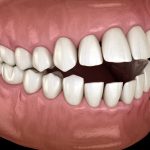Dental malocclusions are quite common. There are three types: class 1, class 2, and class 3.
In this article, we define class 2 malocclusion and explain the types of treatments that can be used to correct it.
Definition of a class 2 malocclusion
Dental malocclusions are classified based on the positioning of the upper and lower molars.
Class 2 (or class II) malocclusions are characterized by upper molars that are too far forward compared to the lower molars. This overbite can be caused by an overly prominent upper jaw or an underdeveloped lower jaw.
Types of class 2 malocclusion
Class 2 malocclusions can be subdivided into two categories, division 1 and division 2. The category is assessed based on the musculature and soft tissues of the face, such as the cheeks, lips and tongue. It is important to determine which category applies to the patient in order to select the best treatment and avoid the consequences of malocclusion.
Here are the characteristics of each division:
- Division 1: A class 2 division 1 malocclusion means that the molars are in the class 2 position and the anterior teeth are protruding. People with this type of malocclusion often experience a slackening of the lips. The lower lip rests behind the upper teeth, accentuating the discrepancy between the jaws.
- Division 2: With division 2, the molars are also in the class 2 position, but the soft tissues in the face and mouth react differently, exerting pressure that tilts the incisors towards the palate.
How to treat class 2 malocclusions
Given that class 2 malocclusions occur in varying degrees of severity, there are several different treatments that can be used to correct the problem. Dental specialists can help you select the right treatment for your malocclusion.
Here are the treatments that can be used to treat class 2 malocclusions:
- For children who are still growing: dentofacial orthopedic treatment to improve mandibular growth
- For mild cases: orthodontic treatment with fixed braces and intermaxillary elastics
- For adults with more severe malocclusion, orthognathic surgery is an option
Orthognathic surgery at Clinique MFML
It is important to treat class 2 malocclusions promptly in order to limit their adverse effects.
If you have a dental malocclusion and your orthodontist recommends orthognathic surgery, contact the oral and maxillofacial surgery specialists at Clinique MFML. With our expertise, we will be able to determine the best solution to treat your problem.
Check out our blog for more information on class 1 and class 3 malocclusions.




